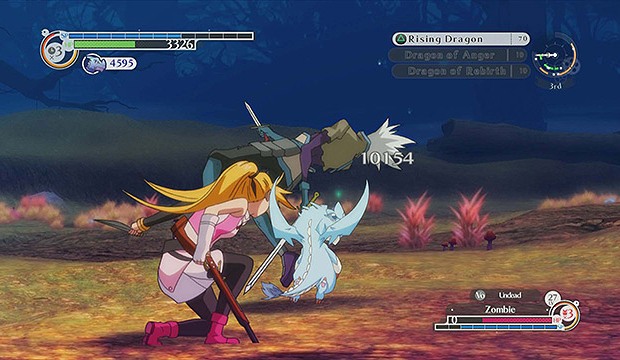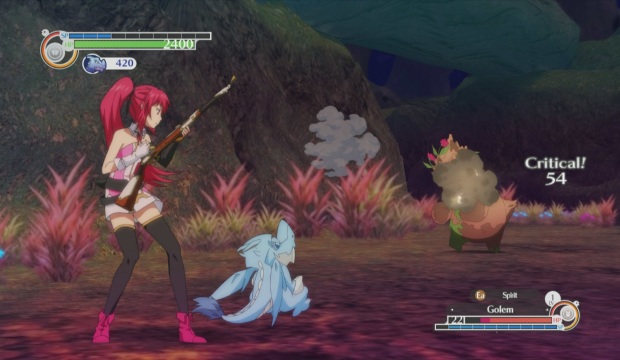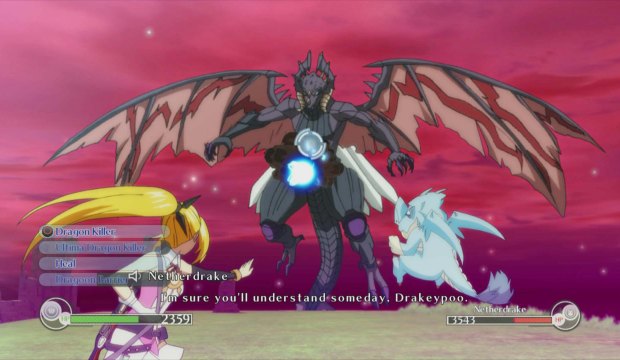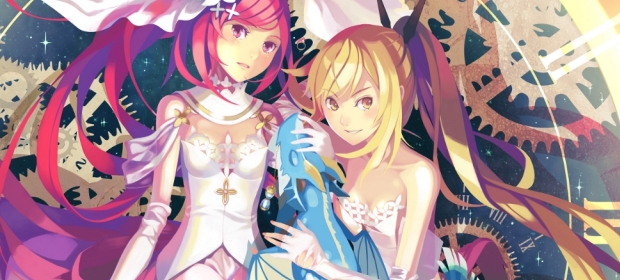Imageepoch are relative newcomers to the RPG scene, gaining a modicum of fame from their Luminous Arc series, some of which have made it over to these shores. We know how ace NIS are, firm Godisageek favourites who have helped us European gamers enjoy a feast of delights in the past few years – including the astonishing Disgaea titles and Atlus masterpiece Persona 4: Golden. In conjunction with Namco Bandai, NIS have decided to give Time & Eternity, the latest action-oriented Imageepoch adventure, a PAL release. Promising a startling HD anime role-player with a unique time travelling story and a healthy dose of girl power, the game known as Tokitowa in the East unfortunately fails to deliver on a number of levels.
Proceedings begin with a textbook slice of doe-eyed Japanese whimsy, main character Toki getting ready for her impending wedding to a cookie-cutter spiky haired cliché of a fiancée while chatting to a gaggle of her misfit buddies. Immediately you notice how irritating everything is – the OTT American voices, the annoying characters, and the propensity to show young ladies clad in inappropriately scanty outfits. Worst of all is the inclusion of Toki’s awful Pokemon-esque sidekick, a blue dragon called Drake, who – crazily – reminded me of the knowingly-crap Niblet from the hysterical Korn South Park episode, such is his banal, vanilla awfulness. When Time & Eternity finally throws in a twist and Drake actually takes on a meaningful role in the plot, you will probably be beyond caring.

This is all a real bloody shame, as the actual story itself is quite sweet and well thought-through, dealing with Toki’s fella being butchered on their wedding day, and her finding a way to travel back in time to discover why the chapel was crashed by a bunch of murderous ninjas. Add into the mix the fact that Toki has a super-aggressive badass alter-ego, and you have what could have been quite a riveting tale in a better overall package. But you realise that you are dealing with a clunker when the dying hero lets fly with some last words that go for bawdy laughs rather than playing on the emotional impact of the situation. Imagine if Oliver’s mum had cracked a dick gag on her deathbed during the highly charged Ni No Kuni opening sequence. Yeah, it’s that bad.
The problems with Time & Eternity rear their ugly head as soon as the cutscenes end and the action begins. Playing using an over the shoulder view (which can be zoomed out slightly), you explore maps, take on quests, and encounter random battles. The alarm bells really started to go off when the first fight consisted of simply hammering the circle button to repeatedly discharge a firearm into the encroaching Golem baddie. Combat purports to be combo-based, and there are elements that could almost be described as rhythm-action-ish (you can sidestep, move backwards and forward, attack using ranged or close attacks). In practice you can win most fights simply by continuing to give that one button a good hiding. After the first couple of fights, during which only circle needs to be employed, it is possible to unlock more than one Trophy, which should tell you how simplistic it is.

Along the way you can unlock skills and magical bits and pieces to assign to the other face buttons, yet when you are essentially just doing the same old thing over and over again (even the boss battles are just bigger enemies with more hit points, really), there is none of the sense of achievement and wonderment that comes from a good levelling-up system. When you finally get around to getting hold of a nice bit of elemental magic, there is a sense of having closed the stable door after the horse has bolted – as your other attacks would have levelled up beyond the skill you were looking to unlock in the poorly-thought-out branching skill tree (which has been done before, infinitely better, in many a Final Fantasy).
Where the grand old names of role-playing lore feature excellent gimmicks that keep things fresh (think of Persona with its S-Links, Chrono Trigger with its genuinely immersive time travelling story), Time & Eternity has a cursory friendship system that allows you to build up the “Affection” felt between you and your oddball mates, which can unlock such delights as more boring cutscenes, stat increases or, oddly, unlockable artwork.

Repetitive combat is one thing, but when the unnecessarily massive world maps are similarly barren and devoid of life, it adds up to a sad experience. Unlike the Ghibli-designed masterpiece that was Ni No Kuni, which was so sublimely beautiful it felt like playing a living, breathing anime epic, Time & Eternity muddles together jerky, wooden, poorly animated sprites, an odd-feeling camera, and a bizarro mix of 2D characters and dreadful 3D landscapes. It is hardly a treat for the ears, either. Dreadful voice acting is the order of the day (the Japanese voice track is apparently available, but it is hard to see how it would improve the experience), and while some of the musical compositions are quite nice (the main theme is ace), you find that the ditty does not always match the action, leading to some jarring matchups.
VERDICT: It is a crushing blow to find yourself playing an NIS-published role player as poor as this. For every glimmer of hope – the quite-nice inanimate sprites and cutscenes, the tastefully-done world map, and the theory behind the combat and story – there are umpteen reasons to dislike what Imageepoch have done here. Structurally it’s a mess, with most missions playing out as grind-fests through dull-as-dishwater locales, and with the kind of misogynistic portrayal of supposedly-strong female characters that gives the genre a bad name, this is the very worst that JRPGs have to offer, and we can only recommend that you divorce yourself from any thoughts of shelling out your hard-earned cash on it.

BAD. Ugly, lazy, and unpleasant, if we’ve scored a game so low then it has serious issues. A 3/10 game will suffer from a combination of uninspired, lacklustre design, unfixed bugs and poor presentation.





